Organizational Behavior of a Business Leader: Frank Woolworth Study
VerifiedAdded on 2023/01/05
|16
|3230
|50
Report
AI Summary
This report delves into the organizational behavior of a business leader, specifically focusing on Frank Woolworth, the founder of Woolworths. It examines his leadership style, key decisions, and the application of contemporary organizational behavior theories, including classical and neoclassical approaches. The report analyzes different types of human behavior in the workplace and how Woolworth managed interpersonal relationships and communication across departments. It explores the importance of teamwork, challenges faced by leaders, and the development of effective strategies to resolve organizational problems. The analysis includes evidence-based management practices and the implementation of personal and interpersonal skills within the organizational context. Overall, the report provides a comprehensive overview of Woolworth's leadership and its impact on the success of the company, offering valuable insights into organizational behavior and management strategies.
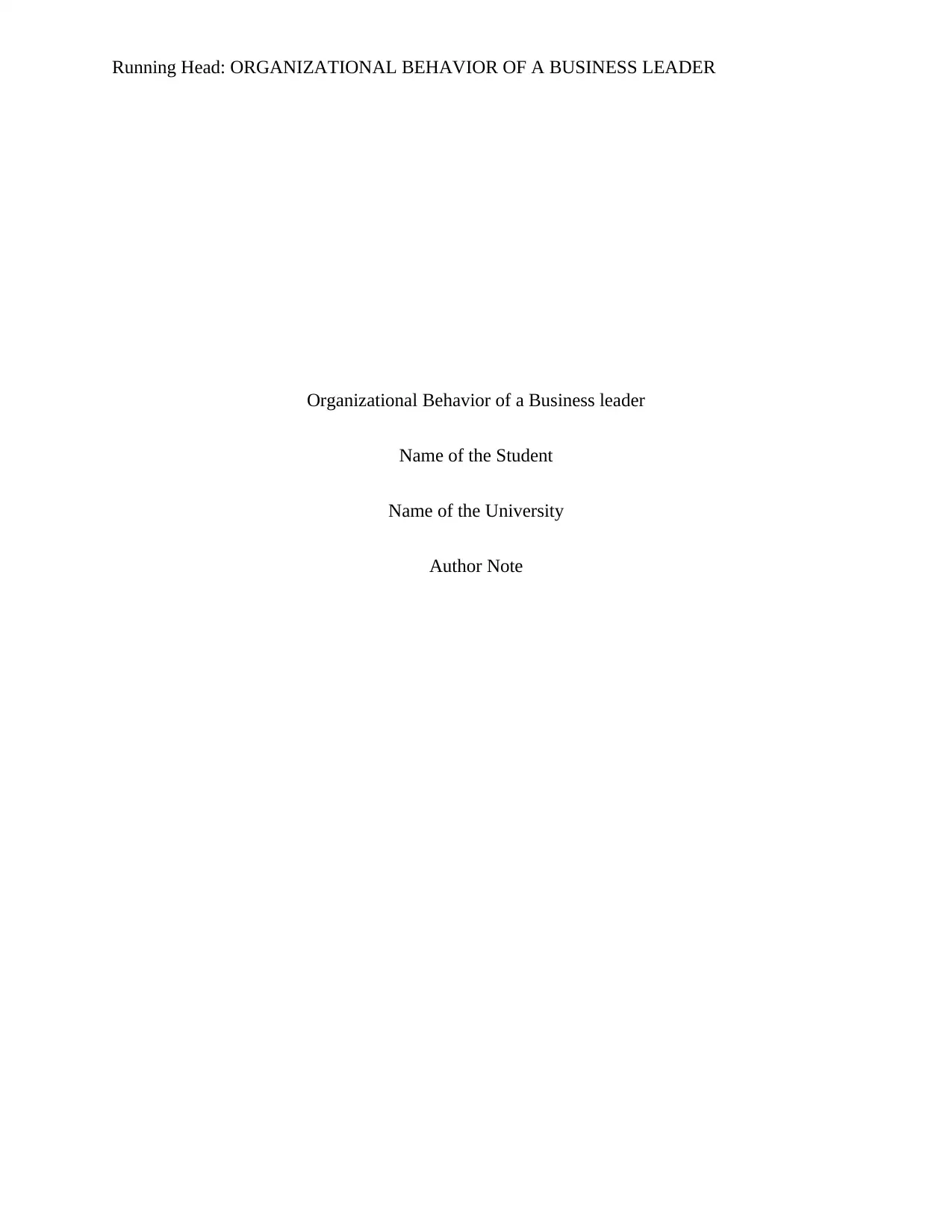
Running Head: ORGANIZATIONAL BEHAVIOR OF A BUSINESS LEADER
Organizational Behavior of a Business leader
Name of the Student
Name of the University
Author Note
Organizational Behavior of a Business leader
Name of the Student
Name of the University
Author Note
Paraphrase This Document
Need a fresh take? Get an instant paraphrase of this document with our AI Paraphraser
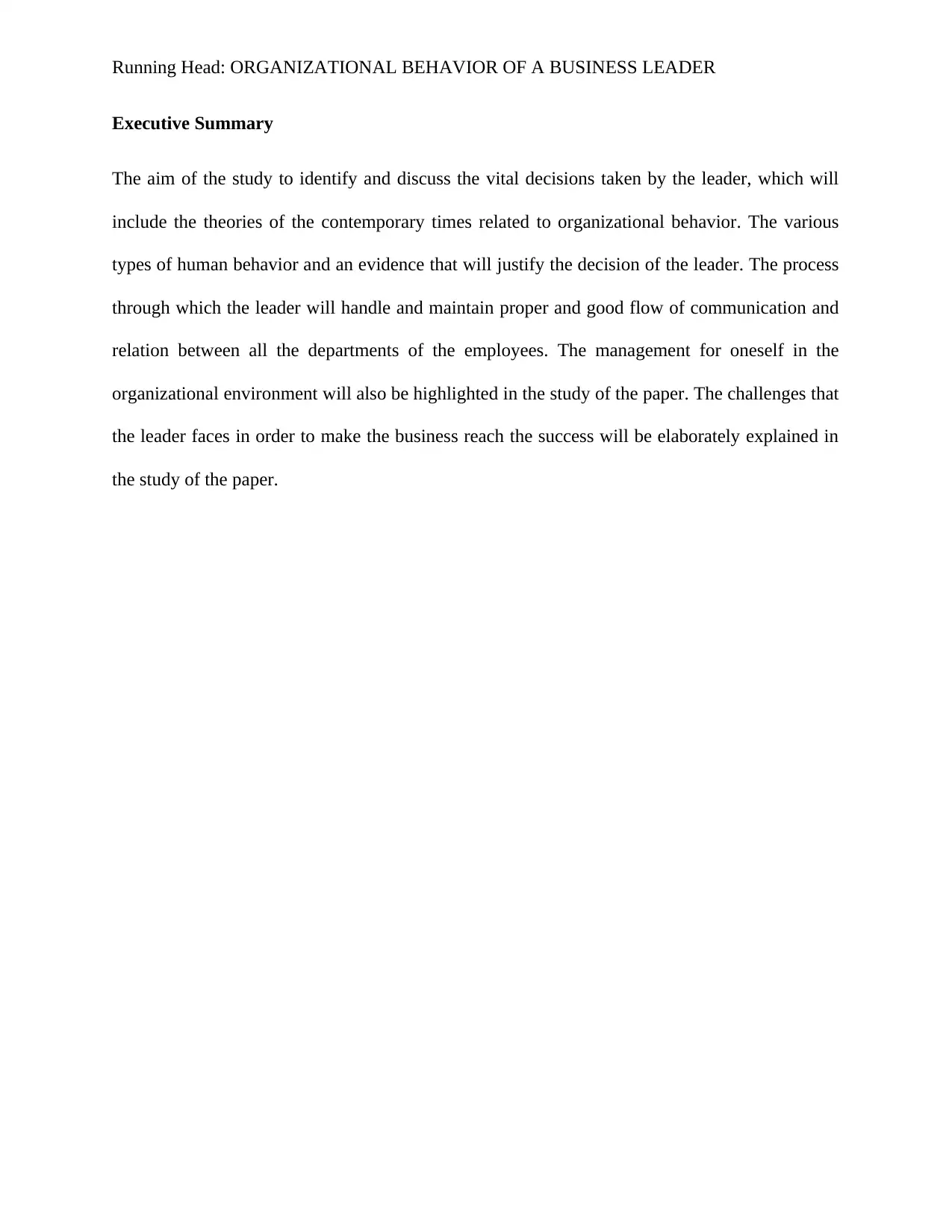
Running Head: ORGANIZATIONAL BEHAVIOR OF A BUSINESS LEADER
Executive Summary
The aim of the study to identify and discuss the vital decisions taken by the leader, which will
include the theories of the contemporary times related to organizational behavior. The various
types of human behavior and an evidence that will justify the decision of the leader. The process
through which the leader will handle and maintain proper and good flow of communication and
relation between all the departments of the employees. The management for oneself in the
organizational environment will also be highlighted in the study of the paper. The challenges that
the leader faces in order to make the business reach the success will be elaborately explained in
the study of the paper.
Executive Summary
The aim of the study to identify and discuss the vital decisions taken by the leader, which will
include the theories of the contemporary times related to organizational behavior. The various
types of human behavior and an evidence that will justify the decision of the leader. The process
through which the leader will handle and maintain proper and good flow of communication and
relation between all the departments of the employees. The management for oneself in the
organizational environment will also be highlighted in the study of the paper. The challenges that
the leader faces in order to make the business reach the success will be elaborately explained in
the study of the paper.
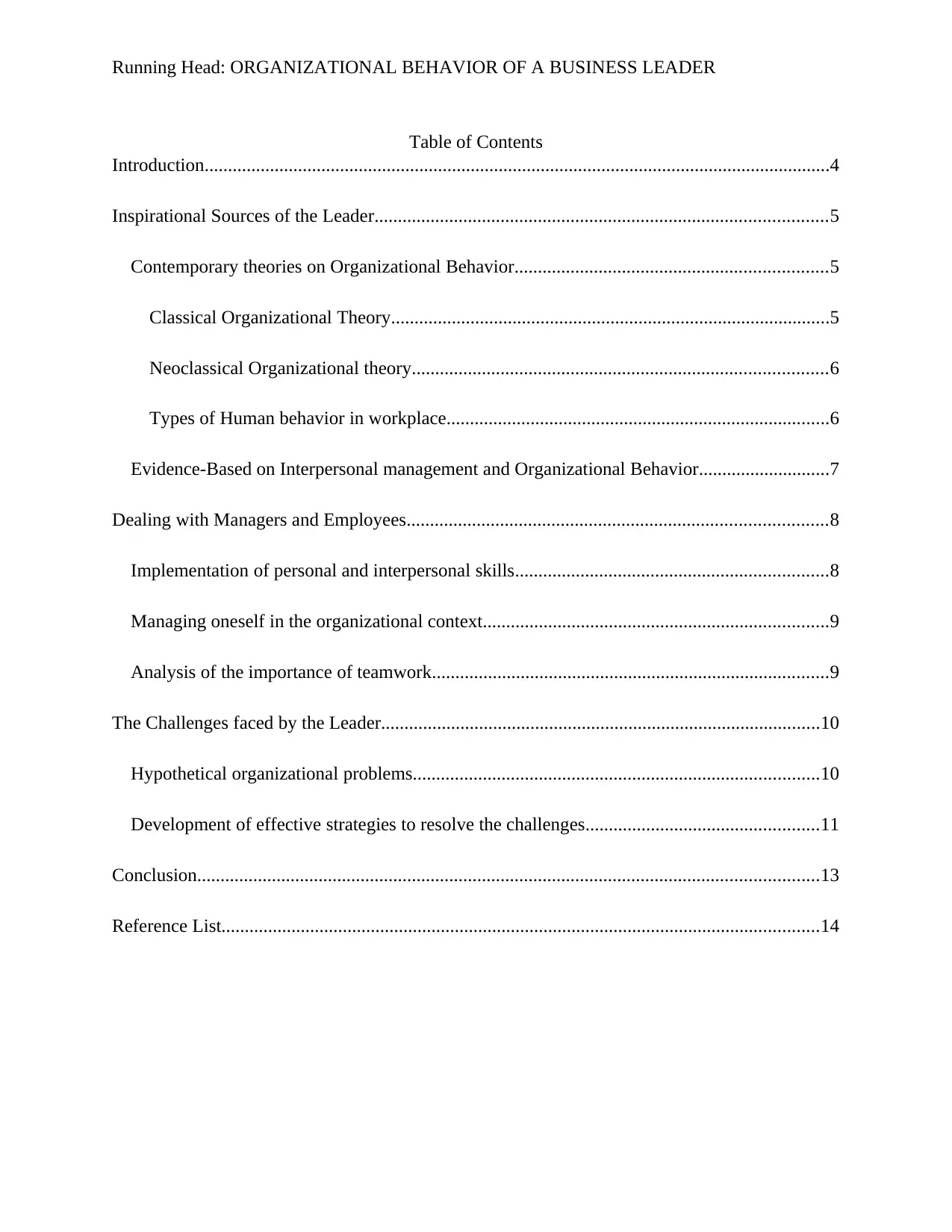
Running Head: ORGANIZATIONAL BEHAVIOR OF A BUSINESS LEADER
Table of Contents
Introduction......................................................................................................................................4
Inspirational Sources of the Leader.................................................................................................5
Contemporary theories on Organizational Behavior...................................................................5
Classical Organizational Theory..............................................................................................5
Neoclassical Organizational theory.........................................................................................6
Types of Human behavior in workplace..................................................................................6
Evidence-Based on Interpersonal management and Organizational Behavior............................7
Dealing with Managers and Employees..........................................................................................8
Implementation of personal and interpersonal skills...................................................................8
Managing oneself in the organizational context..........................................................................9
Analysis of the importance of teamwork.....................................................................................9
The Challenges faced by the Leader..............................................................................................10
Hypothetical organizational problems.......................................................................................10
Development of effective strategies to resolve the challenges..................................................11
Conclusion.....................................................................................................................................13
Reference List................................................................................................................................14
Table of Contents
Introduction......................................................................................................................................4
Inspirational Sources of the Leader.................................................................................................5
Contemporary theories on Organizational Behavior...................................................................5
Classical Organizational Theory..............................................................................................5
Neoclassical Organizational theory.........................................................................................6
Types of Human behavior in workplace..................................................................................6
Evidence-Based on Interpersonal management and Organizational Behavior............................7
Dealing with Managers and Employees..........................................................................................8
Implementation of personal and interpersonal skills...................................................................8
Managing oneself in the organizational context..........................................................................9
Analysis of the importance of teamwork.....................................................................................9
The Challenges faced by the Leader..............................................................................................10
Hypothetical organizational problems.......................................................................................10
Development of effective strategies to resolve the challenges..................................................11
Conclusion.....................................................................................................................................13
Reference List................................................................................................................................14
⊘ This is a preview!⊘
Do you want full access?
Subscribe today to unlock all pages.

Trusted by 1+ million students worldwide
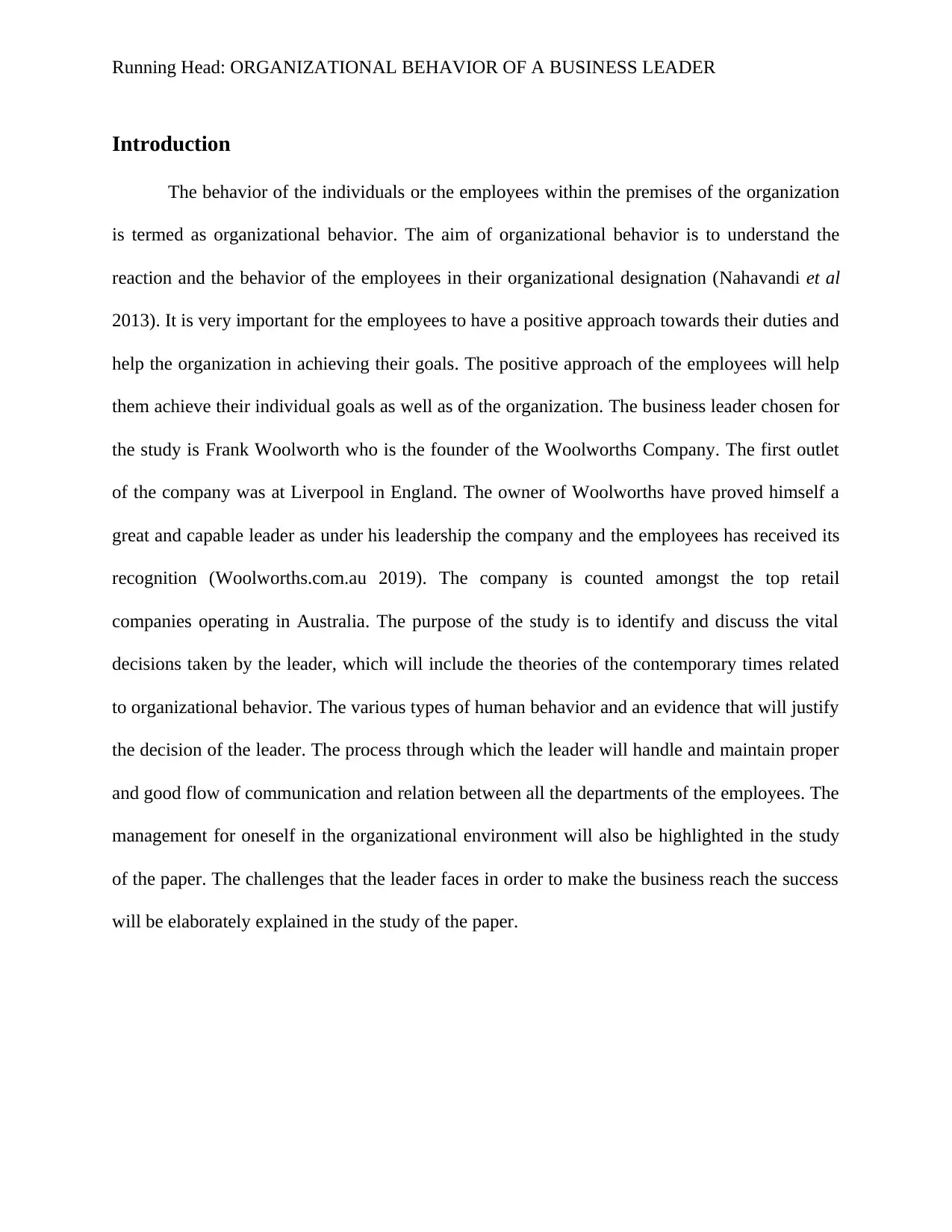
Running Head: ORGANIZATIONAL BEHAVIOR OF A BUSINESS LEADER
Introduction
The behavior of the individuals or the employees within the premises of the organization
is termed as organizational behavior. The aim of organizational behavior is to understand the
reaction and the behavior of the employees in their organizational designation (Nahavandi et al
2013). It is very important for the employees to have a positive approach towards their duties and
help the organization in achieving their goals. The positive approach of the employees will help
them achieve their individual goals as well as of the organization. The business leader chosen for
the study is Frank Woolworth who is the founder of the Woolworths Company. The first outlet
of the company was at Liverpool in England. The owner of Woolworths have proved himself a
great and capable leader as under his leadership the company and the employees has received its
recognition (Woolworths.com.au 2019). The company is counted amongst the top retail
companies operating in Australia. The purpose of the study is to identify and discuss the vital
decisions taken by the leader, which will include the theories of the contemporary times related
to organizational behavior. The various types of human behavior and an evidence that will justify
the decision of the leader. The process through which the leader will handle and maintain proper
and good flow of communication and relation between all the departments of the employees. The
management for oneself in the organizational environment will also be highlighted in the study
of the paper. The challenges that the leader faces in order to make the business reach the success
will be elaborately explained in the study of the paper.
Introduction
The behavior of the individuals or the employees within the premises of the organization
is termed as organizational behavior. The aim of organizational behavior is to understand the
reaction and the behavior of the employees in their organizational designation (Nahavandi et al
2013). It is very important for the employees to have a positive approach towards their duties and
help the organization in achieving their goals. The positive approach of the employees will help
them achieve their individual goals as well as of the organization. The business leader chosen for
the study is Frank Woolworth who is the founder of the Woolworths Company. The first outlet
of the company was at Liverpool in England. The owner of Woolworths have proved himself a
great and capable leader as under his leadership the company and the employees has received its
recognition (Woolworths.com.au 2019). The company is counted amongst the top retail
companies operating in Australia. The purpose of the study is to identify and discuss the vital
decisions taken by the leader, which will include the theories of the contemporary times related
to organizational behavior. The various types of human behavior and an evidence that will justify
the decision of the leader. The process through which the leader will handle and maintain proper
and good flow of communication and relation between all the departments of the employees. The
management for oneself in the organizational environment will also be highlighted in the study
of the paper. The challenges that the leader faces in order to make the business reach the success
will be elaborately explained in the study of the paper.
Paraphrase This Document
Need a fresh take? Get an instant paraphrase of this document with our AI Paraphraser
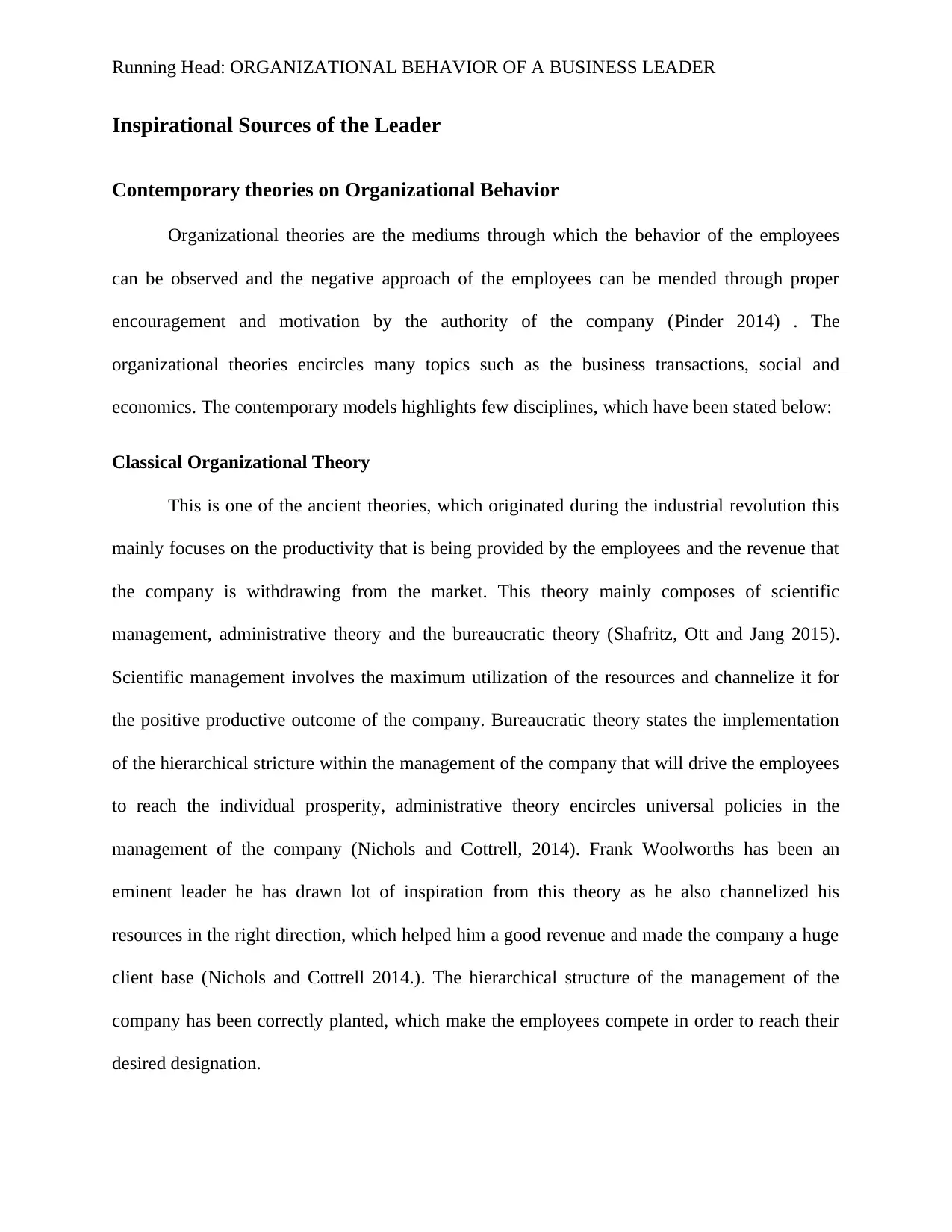
Running Head: ORGANIZATIONAL BEHAVIOR OF A BUSINESS LEADER
Inspirational Sources of the Leader
Contemporary theories on Organizational Behavior
Organizational theories are the mediums through which the behavior of the employees
can be observed and the negative approach of the employees can be mended through proper
encouragement and motivation by the authority of the company (Pinder 2014) . The
organizational theories encircles many topics such as the business transactions, social and
economics. The contemporary models highlights few disciplines, which have been stated below:
Classical Organizational Theory
This is one of the ancient theories, which originated during the industrial revolution this
mainly focuses on the productivity that is being provided by the employees and the revenue that
the company is withdrawing from the market. This theory mainly composes of scientific
management, administrative theory and the bureaucratic theory (Shafritz, Ott and Jang 2015).
Scientific management involves the maximum utilization of the resources and channelize it for
the positive productive outcome of the company. Bureaucratic theory states the implementation
of the hierarchical stricture within the management of the company that will drive the employees
to reach the individual prosperity, administrative theory encircles universal policies in the
management of the company (Nichols and Cottrell, 2014). Frank Woolworths has been an
eminent leader he has drawn lot of inspiration from this theory as he also channelized his
resources in the right direction, which helped him a good revenue and made the company a huge
client base (Nichols and Cottrell 2014.). The hierarchical structure of the management of the
company has been correctly planted, which make the employees compete in order to reach their
desired designation.
Inspirational Sources of the Leader
Contemporary theories on Organizational Behavior
Organizational theories are the mediums through which the behavior of the employees
can be observed and the negative approach of the employees can be mended through proper
encouragement and motivation by the authority of the company (Pinder 2014) . The
organizational theories encircles many topics such as the business transactions, social and
economics. The contemporary models highlights few disciplines, which have been stated below:
Classical Organizational Theory
This is one of the ancient theories, which originated during the industrial revolution this
mainly focuses on the productivity that is being provided by the employees and the revenue that
the company is withdrawing from the market. This theory mainly composes of scientific
management, administrative theory and the bureaucratic theory (Shafritz, Ott and Jang 2015).
Scientific management involves the maximum utilization of the resources and channelize it for
the positive productive outcome of the company. Bureaucratic theory states the implementation
of the hierarchical stricture within the management of the company that will drive the employees
to reach the individual prosperity, administrative theory encircles universal policies in the
management of the company (Nichols and Cottrell, 2014). Frank Woolworths has been an
eminent leader he has drawn lot of inspiration from this theory as he also channelized his
resources in the right direction, which helped him a good revenue and made the company a huge
client base (Nichols and Cottrell 2014.). The hierarchical structure of the management of the
company has been correctly planted, which make the employees compete in order to reach their
desired designation.
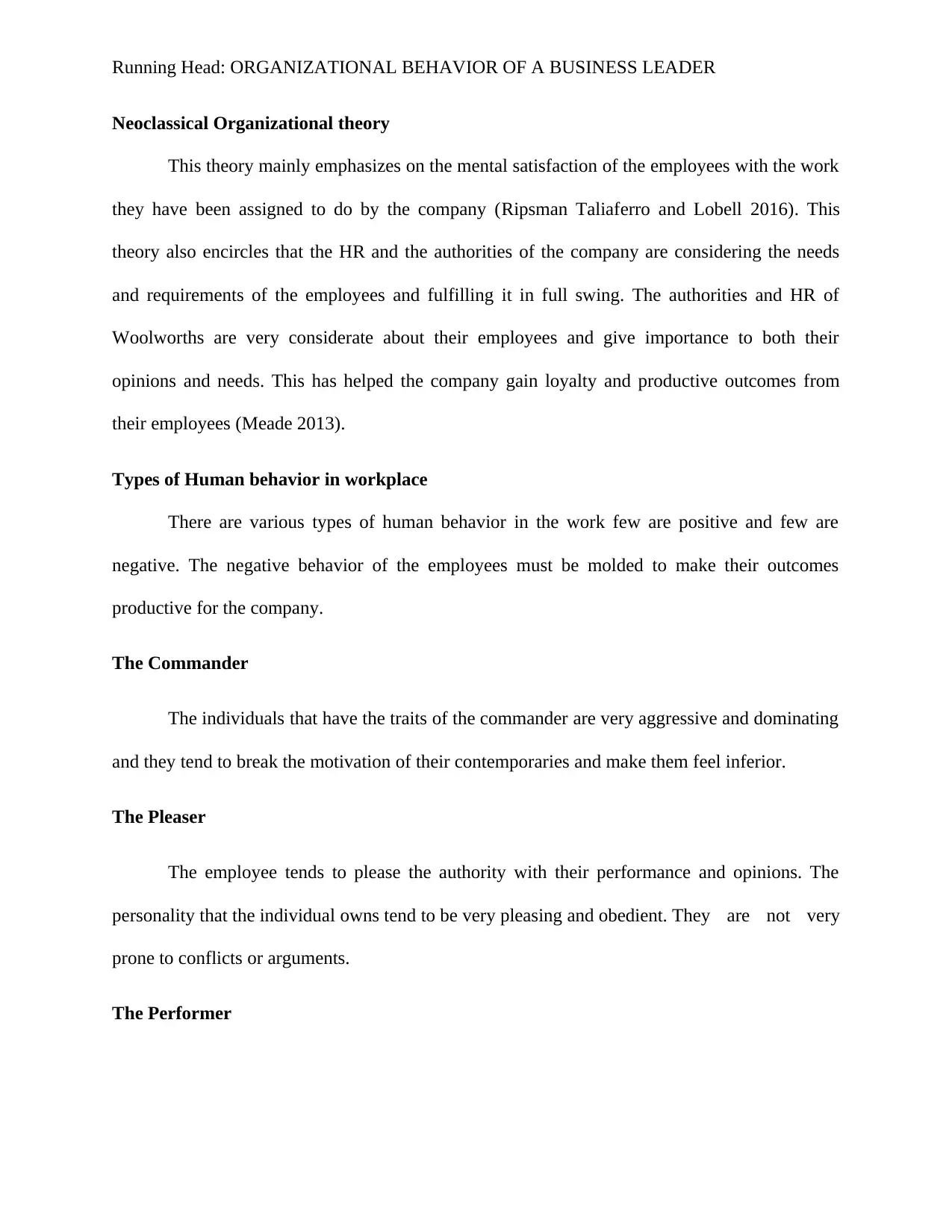
Running Head: ORGANIZATIONAL BEHAVIOR OF A BUSINESS LEADER
Neoclassical Organizational theory
This theory mainly emphasizes on the mental satisfaction of the employees with the work
they have been assigned to do by the company (Ripsman Taliaferro and Lobell 2016). This
theory also encircles that the HR and the authorities of the company are considering the needs
and requirements of the employees and fulfilling it in full swing. The authorities and HR of
Woolworths are very considerate about their employees and give importance to both their
opinions and needs. This has helped the company gain loyalty and productive outcomes from
their employees (Meade 2013).
Types of Human behavior in workplace
There are various types of human behavior in the work few are positive and few are
negative. The negative behavior of the employees must be molded to make their outcomes
productive for the company.
The Commander
The individuals that have the traits of the commander are very aggressive and dominating
and they tend to break the motivation of their contemporaries and make them feel inferior.
The Pleaser
The employee tends to please the authority with their performance and opinions. The
personality that the individual owns tend to be very pleasing and obedient. They are not very
prone to conflicts or arguments.
The Performer
Neoclassical Organizational theory
This theory mainly emphasizes on the mental satisfaction of the employees with the work
they have been assigned to do by the company (Ripsman Taliaferro and Lobell 2016). This
theory also encircles that the HR and the authorities of the company are considering the needs
and requirements of the employees and fulfilling it in full swing. The authorities and HR of
Woolworths are very considerate about their employees and give importance to both their
opinions and needs. This has helped the company gain loyalty and productive outcomes from
their employees (Meade 2013).
Types of Human behavior in workplace
There are various types of human behavior in the work few are positive and few are
negative. The negative behavior of the employees must be molded to make their outcomes
productive for the company.
The Commander
The individuals that have the traits of the commander are very aggressive and dominating
and they tend to break the motivation of their contemporaries and make them feel inferior.
The Pleaser
The employee tends to please the authority with their performance and opinions. The
personality that the individual owns tend to be very pleasing and obedient. They are not very
prone to conflicts or arguments.
The Performer
⊘ This is a preview!⊘
Do you want full access?
Subscribe today to unlock all pages.

Trusted by 1+ million students worldwide
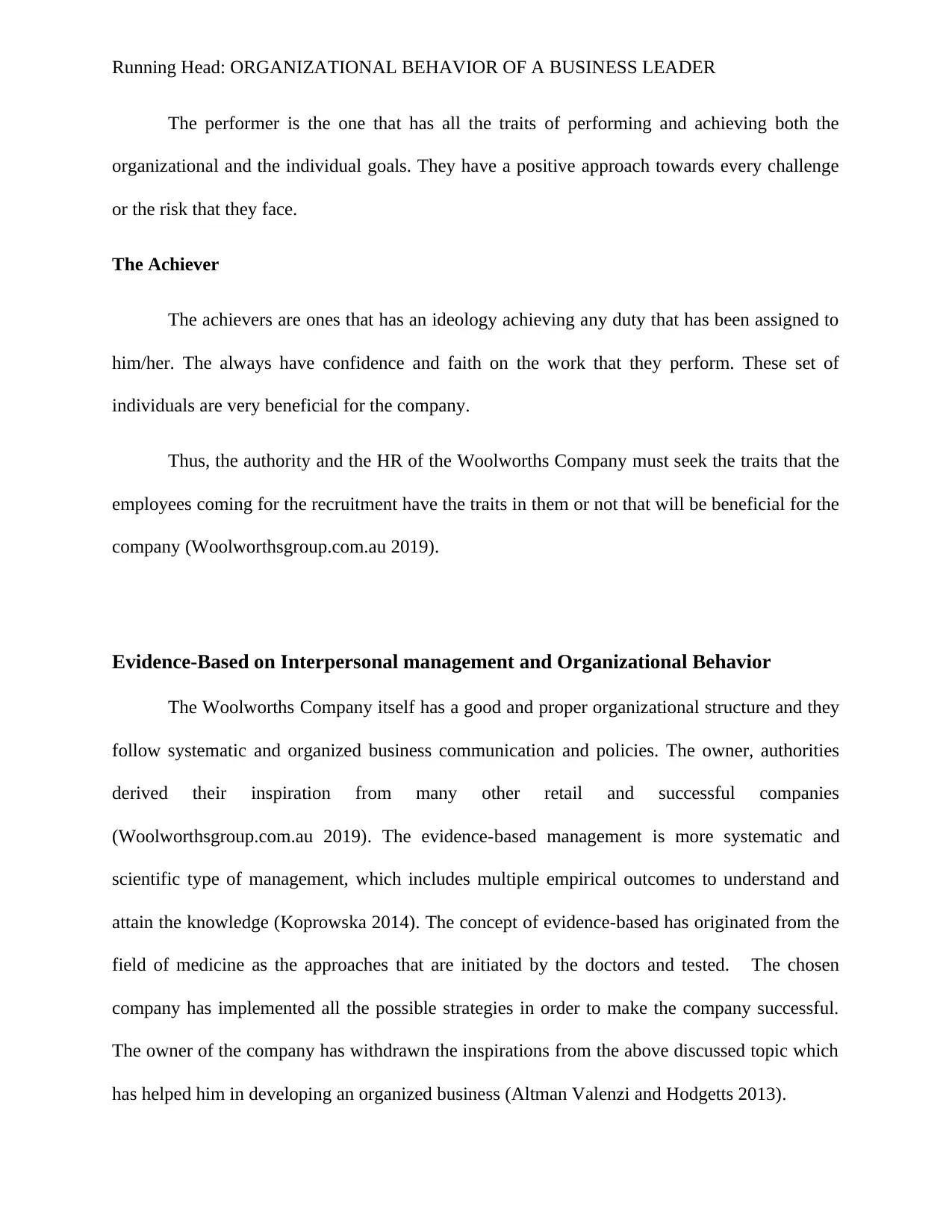
Running Head: ORGANIZATIONAL BEHAVIOR OF A BUSINESS LEADER
The performer is the one that has all the traits of performing and achieving both the
organizational and the individual goals. They have a positive approach towards every challenge
or the risk that they face.
The Achiever
The achievers are ones that has an ideology achieving any duty that has been assigned to
him/her. The always have confidence and faith on the work that they perform. These set of
individuals are very beneficial for the company.
Thus, the authority and the HR of the Woolworths Company must seek the traits that the
employees coming for the recruitment have the traits in them or not that will be beneficial for the
company (Woolworthsgroup.com.au 2019).
Evidence-Based on Interpersonal management and Organizational Behavior
The Woolworths Company itself has a good and proper organizational structure and they
follow systematic and organized business communication and policies. The owner, authorities
derived their inspiration from many other retail and successful companies
(Woolworthsgroup.com.au 2019). The evidence-based management is more systematic and
scientific type of management, which includes multiple empirical outcomes to understand and
attain the knowledge (Koprowska 2014). The concept of evidence-based has originated from the
field of medicine as the approaches that are initiated by the doctors and tested. The chosen
company has implemented all the possible strategies in order to make the company successful.
The owner of the company has withdrawn the inspirations from the above discussed topic which
has helped him in developing an organized business (Altman Valenzi and Hodgetts 2013).
The performer is the one that has all the traits of performing and achieving both the
organizational and the individual goals. They have a positive approach towards every challenge
or the risk that they face.
The Achiever
The achievers are ones that has an ideology achieving any duty that has been assigned to
him/her. The always have confidence and faith on the work that they perform. These set of
individuals are very beneficial for the company.
Thus, the authority and the HR of the Woolworths Company must seek the traits that the
employees coming for the recruitment have the traits in them or not that will be beneficial for the
company (Woolworthsgroup.com.au 2019).
Evidence-Based on Interpersonal management and Organizational Behavior
The Woolworths Company itself has a good and proper organizational structure and they
follow systematic and organized business communication and policies. The owner, authorities
derived their inspiration from many other retail and successful companies
(Woolworthsgroup.com.au 2019). The evidence-based management is more systematic and
scientific type of management, which includes multiple empirical outcomes to understand and
attain the knowledge (Koprowska 2014). The concept of evidence-based has originated from the
field of medicine as the approaches that are initiated by the doctors and tested. The chosen
company has implemented all the possible strategies in order to make the company successful.
The owner of the company has withdrawn the inspirations from the above discussed topic which
has helped him in developing an organized business (Altman Valenzi and Hodgetts 2013).
Paraphrase This Document
Need a fresh take? Get an instant paraphrase of this document with our AI Paraphraser
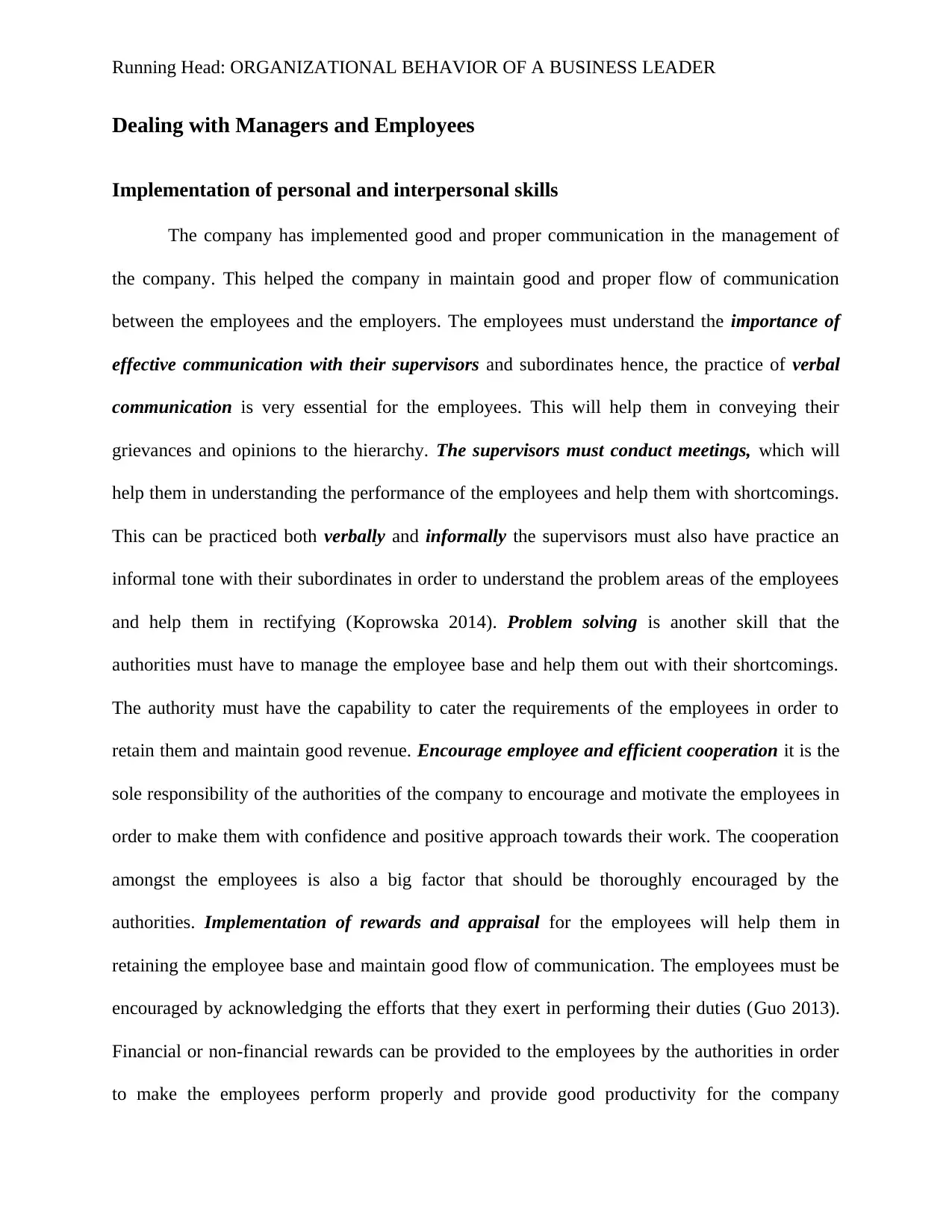
Running Head: ORGANIZATIONAL BEHAVIOR OF A BUSINESS LEADER
Dealing with Managers and Employees
Implementation of personal and interpersonal skills
The company has implemented good and proper communication in the management of
the company. This helped the company in maintain good and proper flow of communication
between the employees and the employers. The employees must understand the importance of
effective communication with their supervisors and subordinates hence, the practice of verbal
communication is very essential for the employees. This will help them in conveying their
grievances and opinions to the hierarchy. The supervisors must conduct meetings, which will
help them in understanding the performance of the employees and help them with shortcomings.
This can be practiced both verbally and informally the supervisors must also have practice an
informal tone with their subordinates in order to understand the problem areas of the employees
and help them in rectifying (Koprowska 2014). Problem solving is another skill that the
authorities must have to manage the employee base and help them out with their shortcomings.
The authority must have the capability to cater the requirements of the employees in order to
retain them and maintain good revenue. Encourage employee and efficient cooperation it is the
sole responsibility of the authorities of the company to encourage and motivate the employees in
order to make them with confidence and positive approach towards their work. The cooperation
amongst the employees is also a big factor that should be thoroughly encouraged by the
authorities. Implementation of rewards and appraisal for the employees will help them in
retaining the employee base and maintain good flow of communication. The employees must be
encouraged by acknowledging the efforts that they exert in performing their duties (Guo 2013).
Financial or non-financial rewards can be provided to the employees by the authorities in order
to make the employees perform properly and provide good productivity for the company
Dealing with Managers and Employees
Implementation of personal and interpersonal skills
The company has implemented good and proper communication in the management of
the company. This helped the company in maintain good and proper flow of communication
between the employees and the employers. The employees must understand the importance of
effective communication with their supervisors and subordinates hence, the practice of verbal
communication is very essential for the employees. This will help them in conveying their
grievances and opinions to the hierarchy. The supervisors must conduct meetings, which will
help them in understanding the performance of the employees and help them with shortcomings.
This can be practiced both verbally and informally the supervisors must also have practice an
informal tone with their subordinates in order to understand the problem areas of the employees
and help them in rectifying (Koprowska 2014). Problem solving is another skill that the
authorities must have to manage the employee base and help them out with their shortcomings.
The authority must have the capability to cater the requirements of the employees in order to
retain them and maintain good revenue. Encourage employee and efficient cooperation it is the
sole responsibility of the authorities of the company to encourage and motivate the employees in
order to make them with confidence and positive approach towards their work. The cooperation
amongst the employees is also a big factor that should be thoroughly encouraged by the
authorities. Implementation of rewards and appraisal for the employees will help them in
retaining the employee base and maintain good flow of communication. The employees must be
encouraged by acknowledging the efforts that they exert in performing their duties (Guo 2013).
Financial or non-financial rewards can be provided to the employees by the authorities in order
to make the employees perform properly and provide good productivity for the company
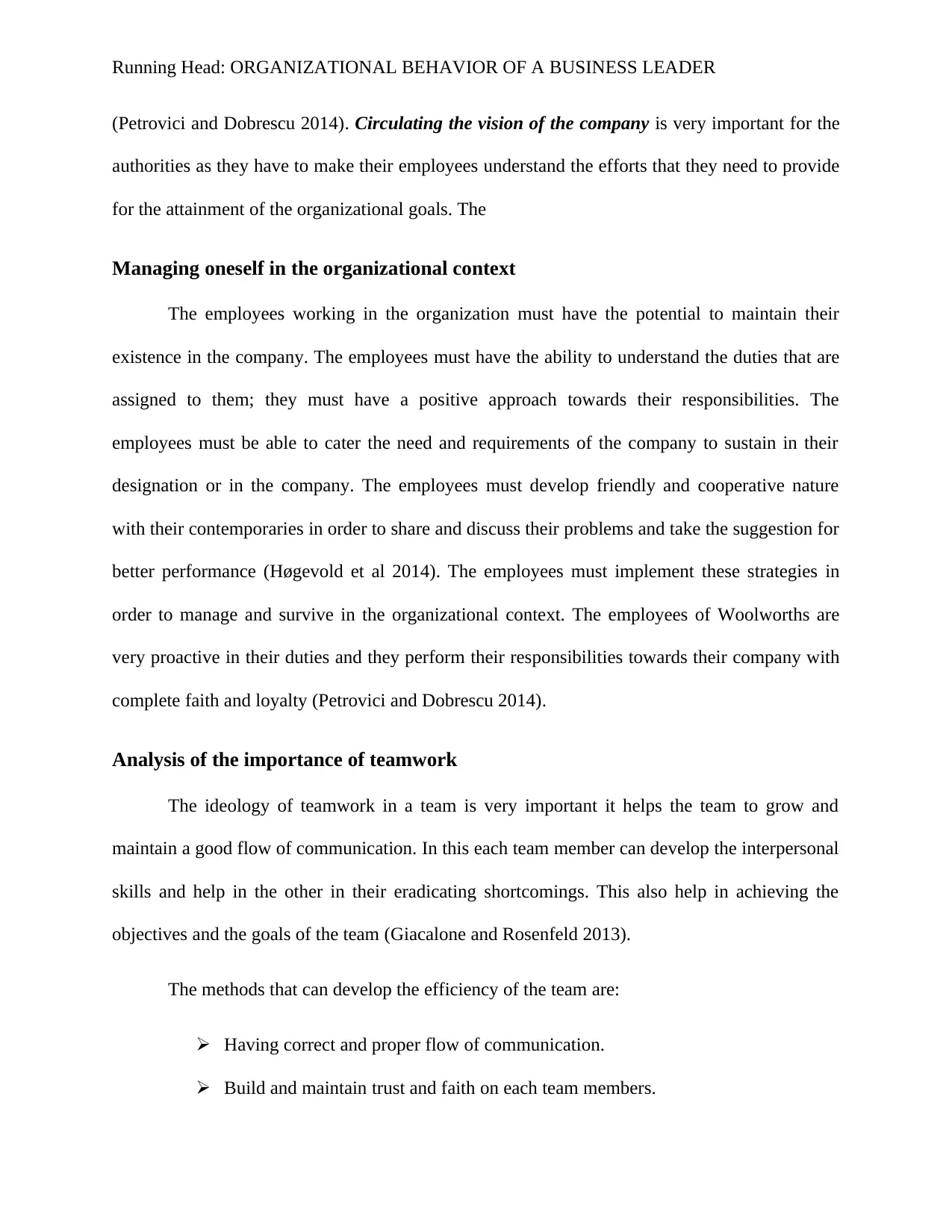
Running Head: ORGANIZATIONAL BEHAVIOR OF A BUSINESS LEADER
(Petrovici and Dobrescu 2014). Circulating the vision of the company is very important for the
authorities as they have to make their employees understand the efforts that they need to provide
for the attainment of the organizational goals. The
Managing oneself in the organizational context
The employees working in the organization must have the potential to maintain their
existence in the company. The employees must have the ability to understand the duties that are
assigned to them; they must have a positive approach towards their responsibilities. The
employees must be able to cater the need and requirements of the company to sustain in their
designation or in the company. The employees must develop friendly and cooperative nature
with their contemporaries in order to share and discuss their problems and take the suggestion for
better performance (Høgevold et al 2014). The employees must implement these strategies in
order to manage and survive in the organizational context. The employees of Woolworths are
very proactive in their duties and they perform their responsibilities towards their company with
complete faith and loyalty (Petrovici and Dobrescu 2014).
Analysis of the importance of teamwork
The ideology of teamwork in a team is very important it helps the team to grow and
maintain a good flow of communication. In this each team member can develop the interpersonal
skills and help in the other in their eradicating shortcomings. This also help in achieving the
objectives and the goals of the team (Giacalone and Rosenfeld 2013).
The methods that can develop the efficiency of the team are:
Having correct and proper flow of communication.
Build and maintain trust and faith on each team members.
(Petrovici and Dobrescu 2014). Circulating the vision of the company is very important for the
authorities as they have to make their employees understand the efforts that they need to provide
for the attainment of the organizational goals. The
Managing oneself in the organizational context
The employees working in the organization must have the potential to maintain their
existence in the company. The employees must have the ability to understand the duties that are
assigned to them; they must have a positive approach towards their responsibilities. The
employees must be able to cater the need and requirements of the company to sustain in their
designation or in the company. The employees must develop friendly and cooperative nature
with their contemporaries in order to share and discuss their problems and take the suggestion for
better performance (Høgevold et al 2014). The employees must implement these strategies in
order to manage and survive in the organizational context. The employees of Woolworths are
very proactive in their duties and they perform their responsibilities towards their company with
complete faith and loyalty (Petrovici and Dobrescu 2014).
Analysis of the importance of teamwork
The ideology of teamwork in a team is very important it helps the team to grow and
maintain a good flow of communication. In this each team member can develop the interpersonal
skills and help in the other in their eradicating shortcomings. This also help in achieving the
objectives and the goals of the team (Giacalone and Rosenfeld 2013).
The methods that can develop the efficiency of the team are:
Having correct and proper flow of communication.
Build and maintain trust and faith on each team members.
⊘ This is a preview!⊘
Do you want full access?
Subscribe today to unlock all pages.

Trusted by 1+ million students worldwide
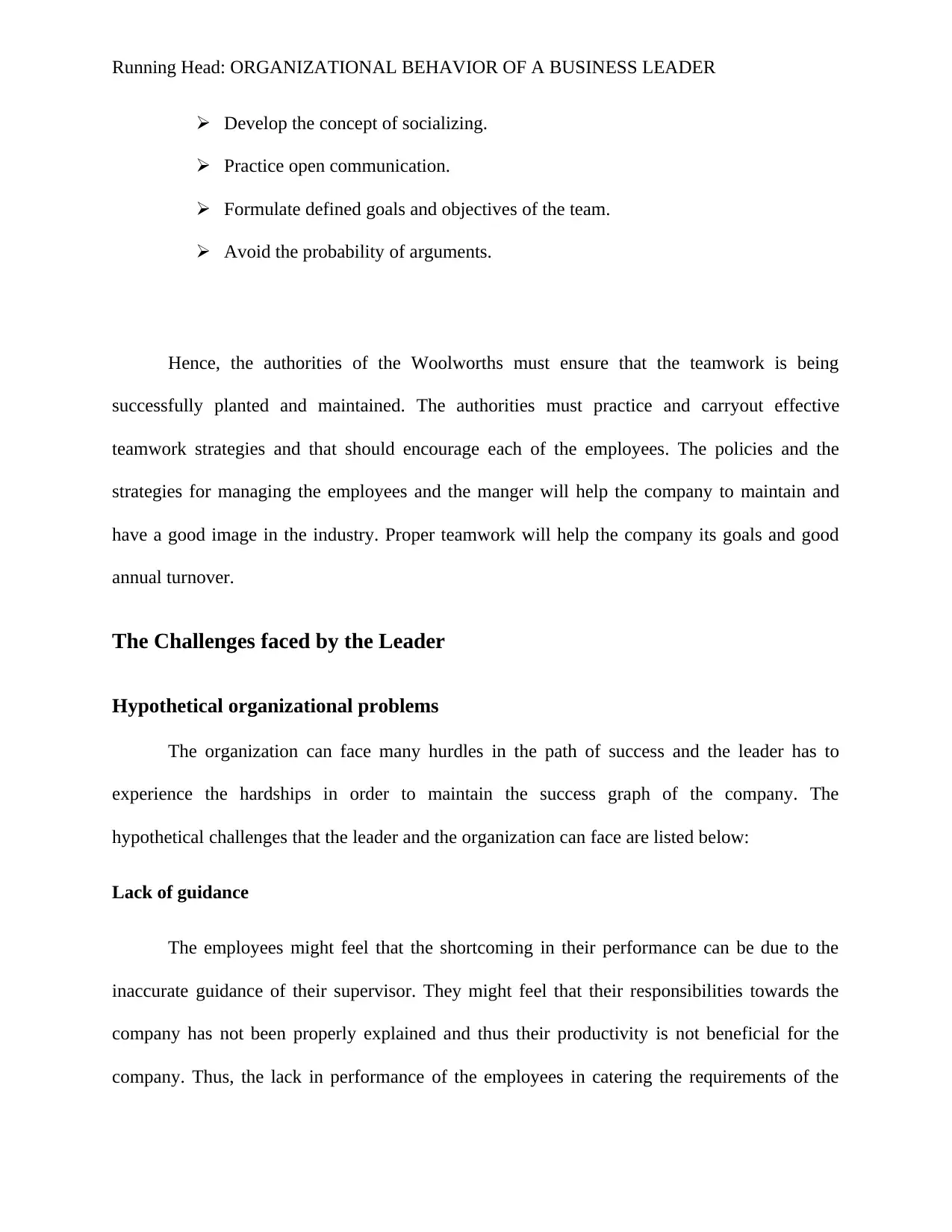
Running Head: ORGANIZATIONAL BEHAVIOR OF A BUSINESS LEADER
Develop the concept of socializing.
Practice open communication.
Formulate defined goals and objectives of the team.
Avoid the probability of arguments.
Hence, the authorities of the Woolworths must ensure that the teamwork is being
successfully planted and maintained. The authorities must practice and carryout effective
teamwork strategies and that should encourage each of the employees. The policies and the
strategies for managing the employees and the manger will help the company to maintain and
have a good image in the industry. Proper teamwork will help the company its goals and good
annual turnover.
The Challenges faced by the Leader
Hypothetical organizational problems
The organization can face many hurdles in the path of success and the leader has to
experience the hardships in order to maintain the success graph of the company. The
hypothetical challenges that the leader and the organization can face are listed below:
Lack of guidance
The employees might feel that the shortcoming in their performance can be due to the
inaccurate guidance of their supervisor. They might feel that their responsibilities towards the
company has not been properly explained and thus their productivity is not beneficial for the
company. Thus, the lack in performance of the employees in catering the requirements of the
Develop the concept of socializing.
Practice open communication.
Formulate defined goals and objectives of the team.
Avoid the probability of arguments.
Hence, the authorities of the Woolworths must ensure that the teamwork is being
successfully planted and maintained. The authorities must practice and carryout effective
teamwork strategies and that should encourage each of the employees. The policies and the
strategies for managing the employees and the manger will help the company to maintain and
have a good image in the industry. Proper teamwork will help the company its goals and good
annual turnover.
The Challenges faced by the Leader
Hypothetical organizational problems
The organization can face many hurdles in the path of success and the leader has to
experience the hardships in order to maintain the success graph of the company. The
hypothetical challenges that the leader and the organization can face are listed below:
Lack of guidance
The employees might feel that the shortcoming in their performance can be due to the
inaccurate guidance of their supervisor. They might feel that their responsibilities towards the
company has not been properly explained and thus their productivity is not beneficial for the
company. Thus, the lack in performance of the employees in catering the requirements of the
Paraphrase This Document
Need a fresh take? Get an instant paraphrase of this document with our AI Paraphraser
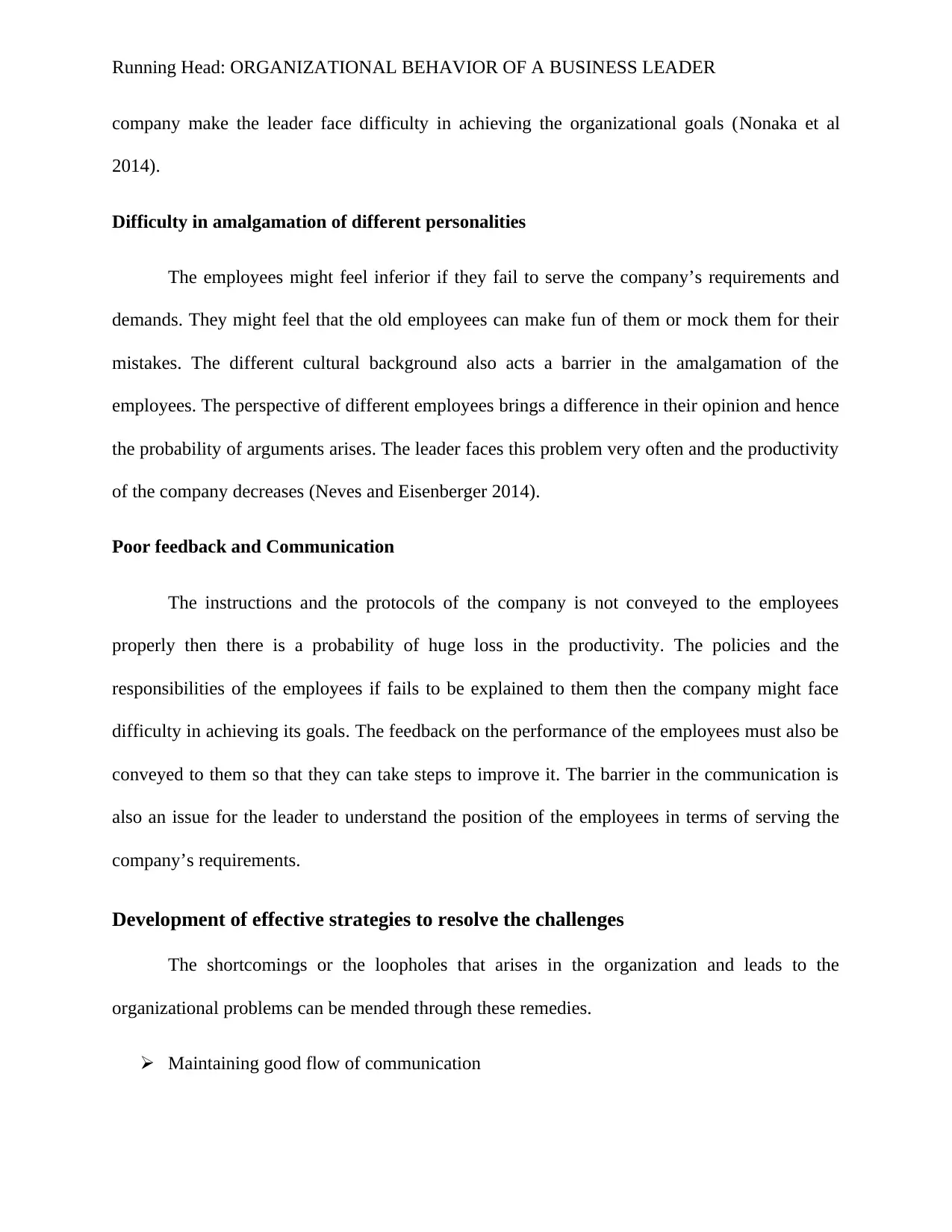
Running Head: ORGANIZATIONAL BEHAVIOR OF A BUSINESS LEADER
company make the leader face difficulty in achieving the organizational goals (Nonaka et al
2014).
Difficulty in amalgamation of different personalities
The employees might feel inferior if they fail to serve the company’s requirements and
demands. They might feel that the old employees can make fun of them or mock them for their
mistakes. The different cultural background also acts a barrier in the amalgamation of the
employees. The perspective of different employees brings a difference in their opinion and hence
the probability of arguments arises. The leader faces this problem very often and the productivity
of the company decreases (Neves and Eisenberger 2014).
Poor feedback and Communication
The instructions and the protocols of the company is not conveyed to the employees
properly then there is a probability of huge loss in the productivity. The policies and the
responsibilities of the employees if fails to be explained to them then the company might face
difficulty in achieving its goals. The feedback on the performance of the employees must also be
conveyed to them so that they can take steps to improve it. The barrier in the communication is
also an issue for the leader to understand the position of the employees in terms of serving the
company’s requirements.
Development of effective strategies to resolve the challenges
The shortcomings or the loopholes that arises in the organization and leads to the
organizational problems can be mended through these remedies.
Maintaining good flow of communication
company make the leader face difficulty in achieving the organizational goals (Nonaka et al
2014).
Difficulty in amalgamation of different personalities
The employees might feel inferior if they fail to serve the company’s requirements and
demands. They might feel that the old employees can make fun of them or mock them for their
mistakes. The different cultural background also acts a barrier in the amalgamation of the
employees. The perspective of different employees brings a difference in their opinion and hence
the probability of arguments arises. The leader faces this problem very often and the productivity
of the company decreases (Neves and Eisenberger 2014).
Poor feedback and Communication
The instructions and the protocols of the company is not conveyed to the employees
properly then there is a probability of huge loss in the productivity. The policies and the
responsibilities of the employees if fails to be explained to them then the company might face
difficulty in achieving its goals. The feedback on the performance of the employees must also be
conveyed to them so that they can take steps to improve it. The barrier in the communication is
also an issue for the leader to understand the position of the employees in terms of serving the
company’s requirements.
Development of effective strategies to resolve the challenges
The shortcomings or the loopholes that arises in the organization and leads to the
organizational problems can be mended through these remedies.
Maintaining good flow of communication
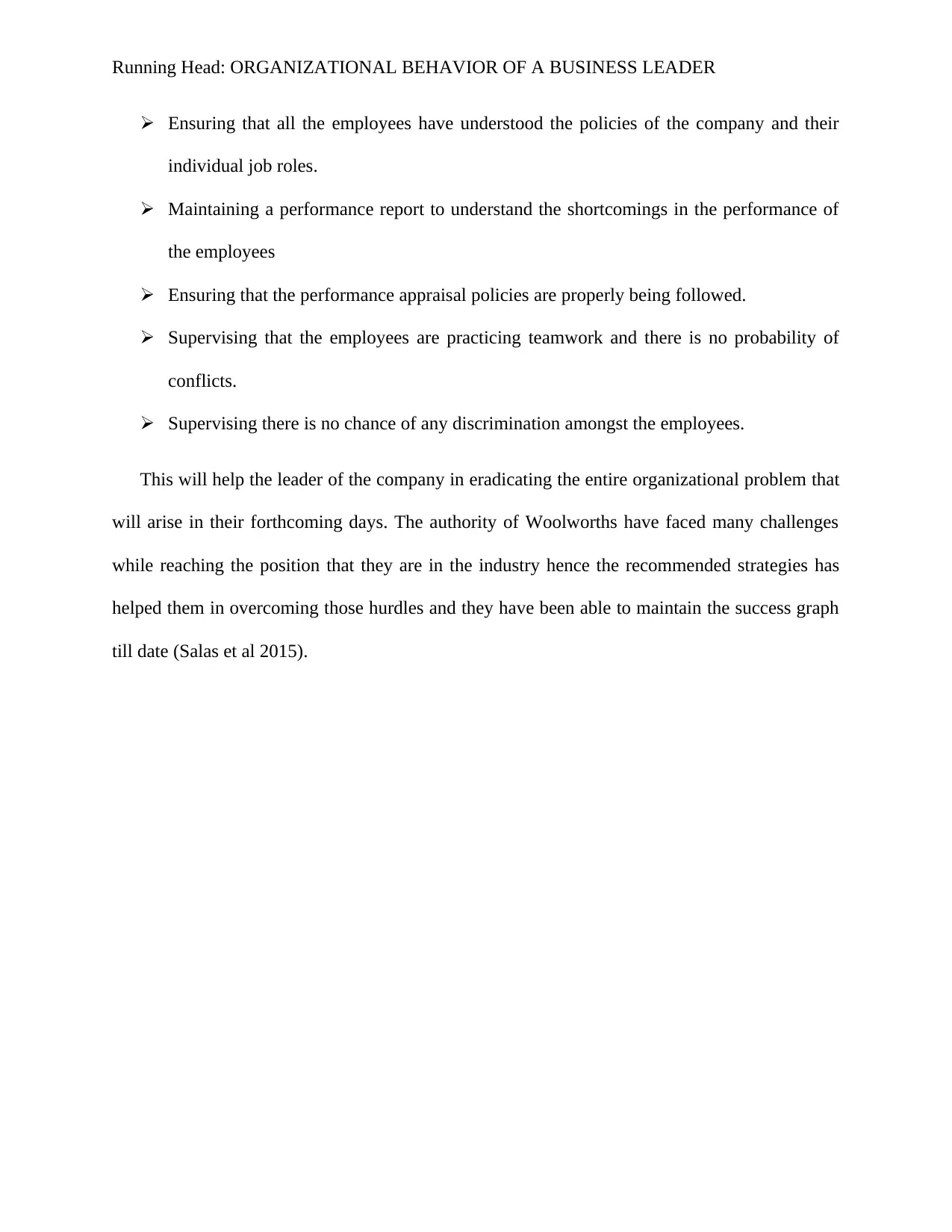
Running Head: ORGANIZATIONAL BEHAVIOR OF A BUSINESS LEADER
Ensuring that all the employees have understood the policies of the company and their
individual job roles.
Maintaining a performance report to understand the shortcomings in the performance of
the employees
Ensuring that the performance appraisal policies are properly being followed.
Supervising that the employees are practicing teamwork and there is no probability of
conflicts.
Supervising there is no chance of any discrimination amongst the employees.
This will help the leader of the company in eradicating the entire organizational problem that
will arise in their forthcoming days. The authority of Woolworths have faced many challenges
while reaching the position that they are in the industry hence the recommended strategies has
helped them in overcoming those hurdles and they have been able to maintain the success graph
till date (Salas et al 2015).
Ensuring that all the employees have understood the policies of the company and their
individual job roles.
Maintaining a performance report to understand the shortcomings in the performance of
the employees
Ensuring that the performance appraisal policies are properly being followed.
Supervising that the employees are practicing teamwork and there is no probability of
conflicts.
Supervising there is no chance of any discrimination amongst the employees.
This will help the leader of the company in eradicating the entire organizational problem that
will arise in their forthcoming days. The authority of Woolworths have faced many challenges
while reaching the position that they are in the industry hence the recommended strategies has
helped them in overcoming those hurdles and they have been able to maintain the success graph
till date (Salas et al 2015).
⊘ This is a preview!⊘
Do you want full access?
Subscribe today to unlock all pages.

Trusted by 1+ million students worldwide
1 out of 16
Related Documents
Your All-in-One AI-Powered Toolkit for Academic Success.
+13062052269
info@desklib.com
Available 24*7 on WhatsApp / Email
![[object Object]](/_next/static/media/star-bottom.7253800d.svg)
Unlock your academic potential
Copyright © 2020–2025 A2Z Services. All Rights Reserved. Developed and managed by ZUCOL.





